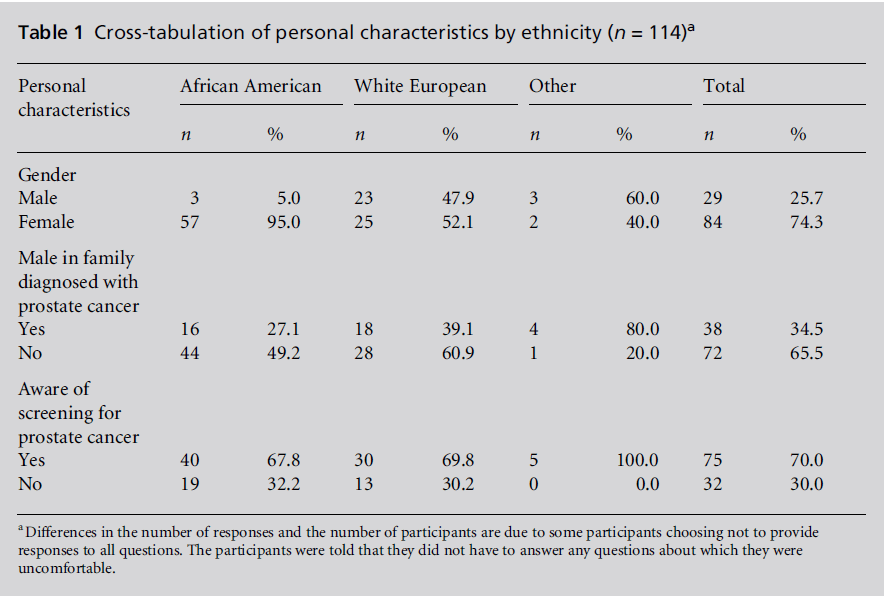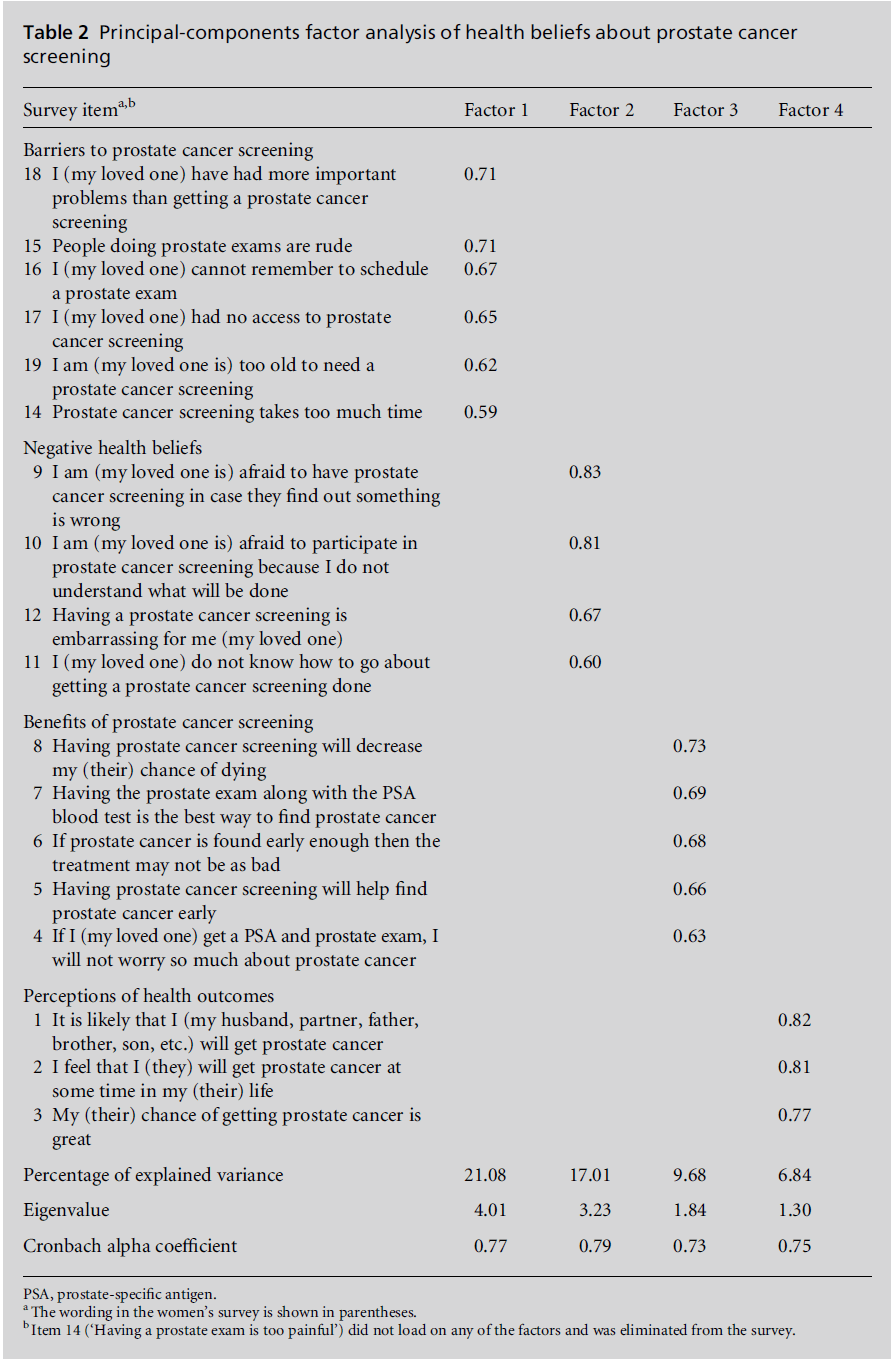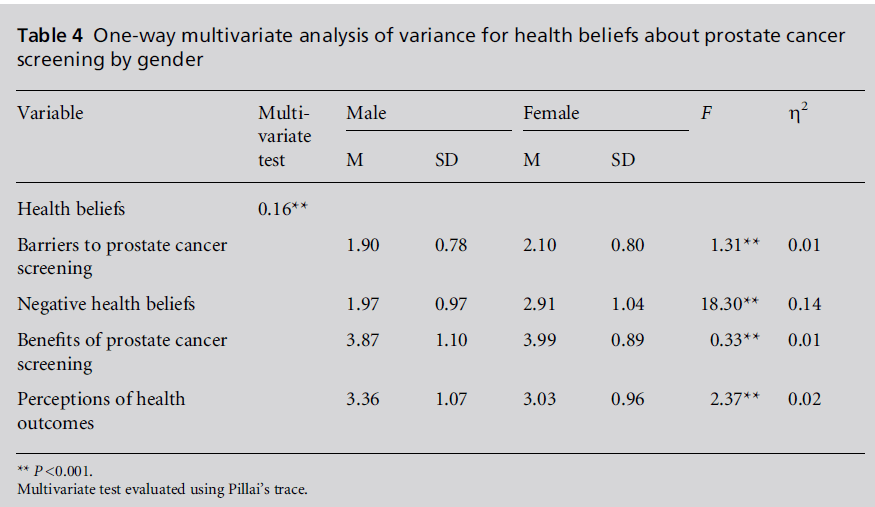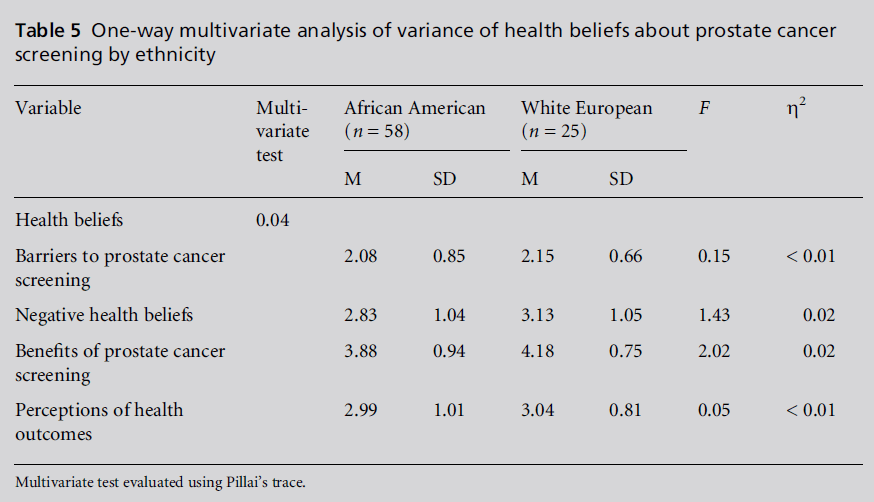Keywords
AfricanAmerican, disparity, health beliefs,
prostate cancer screening, women
Introduction
Prostate cancer is consistently reported to be the leading
cause of cancer deaths among African American men
(American Cancer Society, 2007, 2011). Between 2000
and 2003, more African American men than European
American men died fromprostate cancer (64.0 vs. 26.2
per 100 000) (American Cancer Society, 2007). Deaths
among African American men with this condition
were expected to reach 5300 in 2011 (American Cancer
Society, 2011). In general, mortality rates among black
men are 40.5% higher than those among white men
for all comparable disease processes; moreover, these
mortality rates have not improved for more than 40
years (Satcher et al, 2005). American Cancer Society
(2007) statistics indicate that a delay in diagnosis of
prostate cancer may limit the choice of treatment
options and shorten life expectancy. It is estimated
that the cost of disparities may reach US$ 337 billion
over the next 10 years (Bovbjerg et al, 2009). In
addition, the American Cancer Society has indicated
that when barriers to screening are removed (e.g.
socioeconomic inequalities, disparities in education,
access to healthcare, etc.), differences between African
American men and those from other groups in the
development of prostate cancer are reduced. Consequently,
increasing the rate of participation in prostate
cancer screening among African American men has
the potential to identify prostate cancer at earlier
stages of the disease, resulting in improved treatment
options, decreased healthcare inequalities, and
improved length and quality of life. In this context,
the low uptake of screening among African American
men is an issue of concern. This paper reports on a
study of factors that influence men’s decisions to
undergo screening for prostate cancer.
Literature review
African American men are less likely to be screened for
prostate cancer, and consequently are often diagnosed
at later stages and with a more aggressive disease than
any other group (American Cancer Society, 2007).
The low uptake of screening is suggested to be due to a
number of barriers, including fear and embarrassment
(Forrester-Anderson, 2005; Friedmann et al, 2009),
limited knowledge about prostate cancer (Allen et al,
2007; Forrester-Anderson, 2005; Jones et al, 2009),
lack of resources (Friedmann et al, 2009), family involvement
(Jones et al, 2009), lack of access to healthcare
(Allen et al, 2007), mistrust of the healthcare system,
threats to male sexuality, fear of cancer (Allen et al,
2007), and limited communication within the family
(Friedmann et al, 2009). Despite negative health statistics in the media with regard to African American
men and prostate cancer, one study found that 18 of
105 African American men (17.5%) believed that their
risk of developing prostate cancer was the same as that
for men in other ethnic groups of the same age
(Shavers et al, 2009). In contrast, the same study indicated
that Hispanic men perceived their risk of
developing prostate cancer as being higher than average.
These findings suggested that, in addition to lack of
knowledge about the risk factors associated with
prostate cancer, health beliefs or cultural beliefs may
also influence decision making about screening.
Forrester-Anderson (2005) found that African
American men’s level of knowledge about prostate
cancer screening methods was low. Participants (n =
104) were recruited from three counties in the Metropolitan
Baltimore area. In total, 62 men had health
insurance; most were married, and had at least a highschool
education. The majority (58%) had not participated
in prostate cancer screening, and most of those
who had been screened did not have annual checks.
Several themes were identified: first, there was a need
for African American men to learn more about prostate
cancer; secondly, increased knowledge about prostate
cancer typically resulted in better health; and
thirdly, there was a need to share information about
prostate cancer and African American men with others.
Most participants thought that it would be important
to start men’s health meetings at church.
Emerson et al (2009) designed an educational
intervention study to increase prostate cancer knowledge
among African American men aged 40–70 years.
A total of 345 men were recruited from churches and
divided into two groups: those who were up to date
with screening (n = 193) and those who were not up to
date (n = 152). Among the up-to-date group, 54.9%
had an associate’s degree or higher, 79.2% were married
and 97.9% had health insurance. Among members
of the group that was not up to date, 43.7%had an
associate’s degree or higher, 75.8% were married and
82.2% had some type of health insurance. Of the 152
participants who were not up to date with prostate
cancer screening, 32.2% were able to identify correct
responses to questions related to prostate cancer, but
this figure increased to 49.0% following the educational
intervention. These results, although not optimal,
demonstrate the need not only to educate African
American men about prostate cancer but also to help
them to make informed decisions about undergoing
screening.
In a qualitative study, Jones et al (2009) identified
three major themes that influenced African American
men and their decision as to whether to participate in
prostate cancer screening. Their 17 participants were
aged 40–70 years, seven weremarried, seven were single,
three were divorced, and 12 men were employed. The
three themes identified in this study were limited education about prostate cancer, mistrust in healthcare
providers, and family involvement. The men
reported that they would be more likely to seek prostate
cancer screening if family members were involved in
the decision-making process.
Blocker et al (2006) interviewed 15 African American
women and 14 African American men. The
women in this study asserted that African American
men often put their own needs to one side in order to
concentrate on the needs of the family unit. These
women indicated that they had a responsibility to
advocate for their husband or partner, father, sons,
brothers, uncles, etc. to seek preventative medical care.
Bryan et al (2008) assigned men and women to four
focus groups that were gender and race specific. Eight
African American women between the ages of 35 and
69 years participated in this study. The findings indicated
that both African American men and women
wished to increase their knowledge about prostate
cancer.Webb et al (2006) interviewed 14 women about
prostate cancer screening. The findings indicated that
women were often the key motivators in helping
African American men to decide to participate in
prostate cancer screening. Consequently, mutual decision
making with a female member of the family (such
as a wife or partner, sister, mother or daughter) may be
a significant motivator for African American men to
choose to participate in prostate cancer screening.
However, little is known about the health beliefs of
women with regard to prostate cancer.
Aims of the study
This study had two aims: first, to ascertain whether
cultural influences affect African American men’s
decision making about participation in prostate cancer
screening, and secondly to investigate the health
beliefs of African American and European American
women with regard to prostate cancer risks for the
men in their family.
Theoretical framework
The health belief model developed by Hochbaum
(1956) was used to guide this study. This model
includes four main concepts, namely perceived susceptibility
(the person’s perception of their likelihood
of developing prostate cancer), perceived seriousness
(how dangerous the person considers prostate cancer
to be), perceived benefit (how effectively a behaviour
such as prostate cancer screening will reduce the threat
of prostate cancer) and perceived barriers related to negative perceptions of the prostate cancer screening
procedure.
Methodology
Institutional review board approval
Approval for this research was granted by the ethics
departments of Wayne State University, Detroit, and
Botsford Hospital, Farmington, Michigan. All of the
participants received written information about the
project.
Settings
Data were collected at two locations in the Metropolitan
Detroit area in the summer and autumn of 2010.
The first site was at a health fair offered to African
American elders by the Institutes of Gerontology of
Wayne State University and the University of Michigan.
The second site was a cancer health screening event for
the community at Botsford Hospital.
Health fairs
For those who have a limited income or are under- or
uninsured in the USA, health fairs provide much
needed resources in the form of health promotion
and early detection of disease processes (social capital).
Members of underserved populations are able to
use these and other means (e.g. public agencies) to
gain access to healthcare and preventative healthcare
information that might otherwise be beyond their
reach. The first health fair that was used to collect
data for this study was supported by a federal grant
specifically to promote health in the African American
population in the City of Detroit,Michigan. The second
health fair was open to all populations; physician
volunteers targeted suburban populations in the hope
that participants would choose this hospital for their
future healthcare needs.
Participants
The participants were men and women attending
these health screening events. To be included in the
study, participants had to be over 21 years of age and
able to read and write English. There were no other
inclusion or exclusion criteria. The mean age of the
participants was 56.51 (SD = 13.91) years, with a
median of 57 years. The majority of the participants
were women (n = 84, 74.3%) and African American (n
= 61, 53.5%). Only three men of African American
origin were recruited. In total, 48 (42.1%) of the participants described their ethnicity as white (see Table 1).
Survey instrument
An adaptation of the Health Belief Model Scale developed
by Champion (1999) was used in this study.
Champion developed this scale in order to examine
women’s health beliefs about mammography screening.
The revised scale used in the present study was
developed to investigate health beliefs about prostate
cancer; a male/female version of the scale was developed.
The scale includes 19 items that measure three
components of health beliefs, namely susceptibility,
benefits and barriers. The participants rated each of
the items using a 5-point scale ranging from 1
(‘strongly disagree’) to 5 (‘strongly agree’). The subscales
were scored by adding the numerical responses
to the items on each subscale and dividing the total by
the number of items on the scale to obtain a mean
score that reflected the original scale of measurement.
The use of mean scores for the subscales also allowed
direct comparisons across the three subscales.
Champion (1999) tested her instrument for reliability
and validity. The alpha coefficients obtained
for internal consistency for susceptibility (0.93), benefits
(0.80) and barriers (0.88) indicated that the
instrument had good reliability. The test–retest correlations
for susceptibility (0.70), benefits (0.45) and barriers (0.65) indicated that the instrument had
adequate stability. The instrument has also been tested
for content validity, construct validity and predictive
validity. The adaptations of the instrument for use
with the participants in this study were tested for
validity and reliability. A principal-components factor
analysis with a varimax rotation was used to test the
construct validity of the revised instrument. According
to Osborne and Costello (2004), valid results of a
principal-components factor analysis can be achieved
using a subject-to-item ratio of at least 5 participants
for each survey item. With 114 participants and 19
survey items, the ratio was 6:1. Four factors, namely
barriers to prostate cancer screening, negative health
beliefs, benefits of prostate cancer screening and perceptions
of health outcomes, emerged from the analysis,
explaining 54.6% of the variance. The associated eigenvalues
were greater than 1.00, indicating that the
amount of variance explained by each subscale was
statistically significant. The results of the factor analysis
are shown in Table 2. The internal consistency of
the instrument was tested using Cronbach alpha coefficients.
The coefficients ranged from 0.73 for benefits
of prostate cancer screening to 0.79 for negative
health beliefs.
The instrument was also tested for readability. The
results of this analysis indicated that the instrument
was at 8th-grade level and could be read by most
people.
Table 1 :Cross-tabulation of personal characteristics by ethnicity (n = 114)a
Table 2 :Principal-components factor analysis of health beliefs about prostate cancer
screening
Data analysis
The data were analysed using IBM-SPSS version 20.0.
The analyses included descriptive statistics to provide
a description of the sample. The aims were tested using
Pearson product–moment correlations and one-way
multivariate analysis of variance (MANOVA). All
decisions about the statistical significance of the
findings were made using a criterion alpha level of
0.05.
Findings
The four subscales that measured health beliefs about
prostate cancer screening were correlated with the age
of the women in the study. One statistically significant
correlation was found for perceptions of health outcomes
(r = 0.27, P = 0.02). The positive direction of the
relationship indicated that older women had more
positive perceptions of health outcomes. The other
correlationswere not statistically significant (seeTable 3).
A one-way MANOVA was used to determine
whether men and women differed on the four subscales
that measured health beliefs (see Table 4). A
statistically significant omnibus F was obtained on the
MANOVA (F (4, 109) = 6.03, P < 0.001). The intersubject
effects were examined in order to determine
which of the four scales were contributing to the
statistically significant difference. Negative health beliefs
differed between men and women (F (1, 112) = 18.31,
P < 0.001). Women (M = 2.91, SD = 1.04) had higher
scores than men (M= 1.97, SD = 0.97), indicating that
they were more likely to perceive that negative health
beliefs were one reason why men in their family did
not seek prostate cancer screening. Although the
difference in negative health beliefs was statistically
significant, the low η2 of 0.14 indicated that the results
had low to moderate practical significance.
A one-way MANOVA was completed to determine
whether African American and European American
participants differed in their health beliefs about prostate cancer screening (see Table 5). The results
of this analysis were not statistically significant. The
low η2 for the analyses provided additional support
for the low significance of the findings. Although the
African American participants had lower scores on
each of the four subscales, these differences were not
statistically significant.
Limitations
Although the strength of this study is that very little
was previously known about women and health beliefs
about prostate cancer, we acknowledge that it has a
number of limitations. African Americans are generally
reluctant to participate in research, and consequently
may not provide answers to all of the items in a survey.
In addition, our sample sizewas small and drawn from
only one geographical area. The selective nature of
populations who attend health fair events may affect
the generalisability of the results.
Conclusion
Little attention has been paid to the health beliefs of
women about prostate cancer. The findings of this
study indicate that women in general perceived that
the main reason why men avoided prostate cancer
screening was their negative health beliefs. This is an
important finding. Directing prostate cancer education
towards women may enable them to motivate
male family members to undergo screening, but any
educational interventions need to be culturally appropriate
for both women and men. Informing individuals
about prostate cancer is not enough; they also
need to know how to access screening. Providing one
without the other would be an exercise in futility. The
results of this study can be used to develop innovative
interventions that reduce or minimise healthcare inequalities
related to prostate cancer, promote health- seeking behaviour, and improve quality of life by
targeting women in the educational and decisionmaking
process.
Table 3 :Pearson product–moment correlations for health beliefs about prostate cancer
screening by age (women only).
Table 4 :One-way multivariate analysis of variance for health beliefs about prostate cancer
screening by gender.
Table 5:One-way multivariate analysis of variance of health beliefs about prostate cancer
screening by ethnicity.
Previous studies have established that when barriers
to prostate cancer screening were removed, differences
in the development of prostate cancer between African
American men and men from other ethnic groups
were reduced (American Cancer Society, 2007). The
most important barrier to prostate cancer screening in
the African American population may be access to
care. This challenges reports from previous studies which highlighted factors such as threats to male
sexuality, and fear of cancer (Allen et al, 2007;
Forrester-Anderson, 2005; Jones et al, 2009), as barriers
specific to African American men.
The implications for both nursing and medical
practice are to encourage the process of developing
interventions designed to include both men and women
because, although disease processes may be gender
specific, coping and effective decision making are
more often undertaken in partnership with significant
family members or friends. The development of edu- cational modules that are gender neutral and disease
specific, including information on how to access
screening, can facilitate early detection of prostate
cancer. This may increase life expectancy and quality
of life for African American men as well as saving the
healthcare services many billions of dollars.
CONFLICTS OF INTEREST
None.
References
- Allen JD, Kennedy M, Wilson-Glover A et al (2007) African- American men’s perceptions about prostate cancer: implications for designing educational interventions. Social Science and Medicine 64:2189–200.
- American Cancer Society (2007) Cancer Facts and Figures for African Americans 2007–2008. Atlanta, GA: American Cancer Society.
- American Cancer Society (2011) Cancer Facts and Figures for African Americans 2011–2012. www.cancer.org/acs/groups/ content@epidemiology.
- Blocker DE, Romocki LS, Thomas KB et al (2006) Knowledge, beliefs and barriers associated with prostate cancer prevention and screening behaviors among African- American men. Journal of the National Medical Association 98:1286–95.
- Bovbjerg RR, Hatry HP and Morley E (2009) Making a Business Case for Reducing Racial and Ethnic Disparities in Healthcare: key issues and observations. Washington, DC: Urban Institute.
- Bryan CJ, Wetmore-Arkader L, Calvano T et al (2008) Using focus groups to adapt ethnically appropriate, information- seeking and recruitment messages for a prostate cancer screening program for men at high risk. Journal of the National Medical Association 100:674–82.
- Champion VL (1999) Revised susceptibility, benefits, and barriers scale for mammography screening. Research in Nursing and Health 22:341–8.
- Emerson JS, Reece MC and Levine RS (2009) Predictors of new screening for African American men participating in a prostate cancer educational program. Journal of Cancer Education 24:341–5.
- Forrester-Anderson IT (2005) Prostate cancer screening perceptions, knowledge, and behaviors among African American men: focus group findings. Journal of Health Care for the Poor and Underserved 16(Suppl. A):22–30.
- Friedmann EF, Corwin SJ, Rose ID et al (2009) Prostate cancer communication strategies recommended by older African-American men in South Carolina: a qualitative analysis. Journal of Cancer Education 24:204–9.
- Hochbaum GM (1956) Why people seek diagnostic X-rays. Public Health Reports 71:377–80. Jones RA, Steeves R and Williams I (2009) Strategies for recruiting African American men into prostate cancer studies. Nursing Research 58:452–6.
- Osborne JW and Costello AB (2004) Sample size and subject to item ratio in principal components analysis. Practical Assessment, Research and Evaluation 9:1–14.
- Satcher D, Fryer GE, McCann J et al (2005) What if we were equal? A comparison of the black–white mortality gap in 1960 and 2000. Health Affairs 24:459–64.
- Shavers VL, Underwood W and Moser RP (2009) Race/ ethnicity and the perception of the risk of developing prostate cancer. American Journal of Preventive Medicine 3:64–7.
- Webb CR, Kronheim L, Williams JE et al (2006) An evaluation of the knowledge, attitudes, and beliefs of African-American men and their female significant others regarding prostate cancer screening. Ethnicity and Disease 16:234–8.






